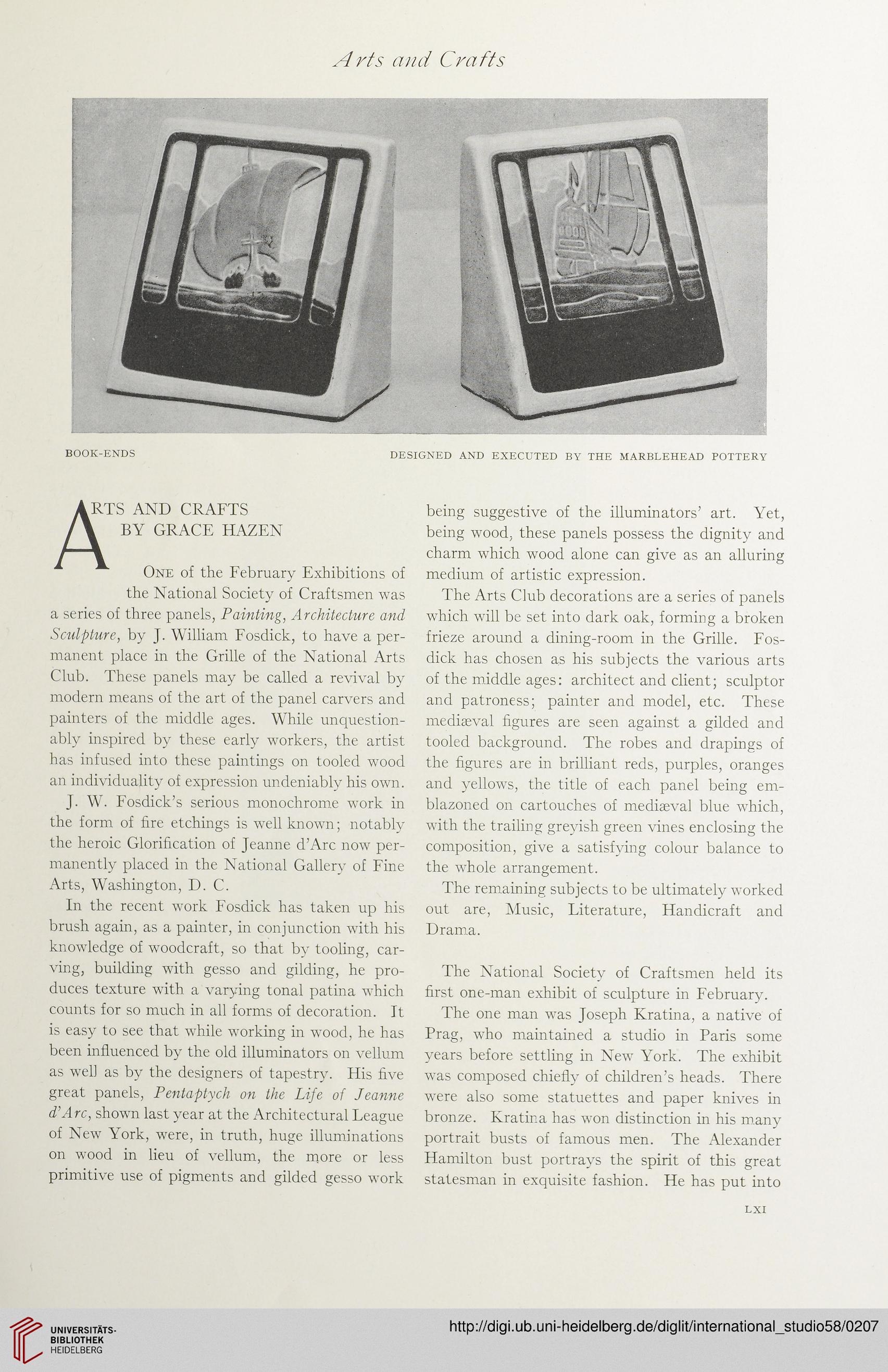Arts and Crafts
BOOK-ENDS DESIGNED AND EXECUTED BY THE MARBLEHEAD POTTERY
Arts and crafts
/\ BY GRACE HAZEN
One of the February Exhibitions of
the National Society of Craftsmen was
a series of three panels, Painting, Architecture and
Sculpture, by J. William Fosdick, to have a per-
manent place in the Grille of the National Arts
Club. These panels may be called a revival by
modern means of the art of the panel carvers and
painters of the middle ages. While unquestion-
ably inspired by these early workers, the artist
has infused into these paintings on tooled wood
an individuality of expression undeniably his own.
J. W. Fosdick’s serious monochrome work in
the form of fire etchings is well known; notably
the heroic Glorification of Jeanne d’Arc now per-
manently placed in the National Gallery of Fine
Arts, Washington, D. C.
In the recent work Fosdick has taken up his
brush again, as a painter, in conjunction with his
knowledge of woodcraft, so that by tooling, car-
ving, building with gesso and gilding, he pro-
duces texture with a varying tonal patina which
counts for so much in all forms of decoration. It
is easy to see that while working in wood, he has
been influenced by the old illuminators on vellum
as well as by the designers of tapestry. His five
great panels, Pentaptych on the Life of Jeanne
d’Arc, shown last year at the Architectural League
of New York, were, in truth, huge illuminations
on wood in lieu of vellum, the more or less
primitive use of pigments and gilded gesso work
being suggestive of the illuminators’ art. Yet,
being wood, these panels possess the dignity and
charm which wood alone can give as an alluring
medium of artistic expression.
The Arts Club decorations are a series of panels
which will be set into dark oak, forming a broken
frieze around a dining-room in the Grille. Fos-
dick has chosen as his subjects the various arts
of the middle ages: architect and client; sculptor
and patroness; painter and model, etc. These
mediaeval figures are seen against a gilded and
tooled background. The robes and drapings of
the figures are in brilliant reds, purples, oranges
and yellows, the title of each panel being em-
blazoned on cartouches of mediaeval blue which,
with the trailing greyish green vines enclosing the
composition, give a satisfying colour balance to
the whole arrangement.
The remaining subjects to be ultimately worked
out are, Music, Literature, Handicraft and
Drama.
The National Society of Craftsmen held its
first one-man exhibit of sculpture in February.
The one man was Joseph Kratina, a native of
Prag, who maintained a studio in Paris some
years before settling in New York. The exhibit
was composed chiefly of children’s heads. There
were also some statuettes and paper knives in
bronze. Kratina has won distinction in his many
portrait busts of famous men. The Alexander
Hamilton bust portrays the spirit of this great
statesman in exquisite fashion. He has put into
LXI
BOOK-ENDS DESIGNED AND EXECUTED BY THE MARBLEHEAD POTTERY
Arts and crafts
/\ BY GRACE HAZEN
One of the February Exhibitions of
the National Society of Craftsmen was
a series of three panels, Painting, Architecture and
Sculpture, by J. William Fosdick, to have a per-
manent place in the Grille of the National Arts
Club. These panels may be called a revival by
modern means of the art of the panel carvers and
painters of the middle ages. While unquestion-
ably inspired by these early workers, the artist
has infused into these paintings on tooled wood
an individuality of expression undeniably his own.
J. W. Fosdick’s serious monochrome work in
the form of fire etchings is well known; notably
the heroic Glorification of Jeanne d’Arc now per-
manently placed in the National Gallery of Fine
Arts, Washington, D. C.
In the recent work Fosdick has taken up his
brush again, as a painter, in conjunction with his
knowledge of woodcraft, so that by tooling, car-
ving, building with gesso and gilding, he pro-
duces texture with a varying tonal patina which
counts for so much in all forms of decoration. It
is easy to see that while working in wood, he has
been influenced by the old illuminators on vellum
as well as by the designers of tapestry. His five
great panels, Pentaptych on the Life of Jeanne
d’Arc, shown last year at the Architectural League
of New York, were, in truth, huge illuminations
on wood in lieu of vellum, the more or less
primitive use of pigments and gilded gesso work
being suggestive of the illuminators’ art. Yet,
being wood, these panels possess the dignity and
charm which wood alone can give as an alluring
medium of artistic expression.
The Arts Club decorations are a series of panels
which will be set into dark oak, forming a broken
frieze around a dining-room in the Grille. Fos-
dick has chosen as his subjects the various arts
of the middle ages: architect and client; sculptor
and patroness; painter and model, etc. These
mediaeval figures are seen against a gilded and
tooled background. The robes and drapings of
the figures are in brilliant reds, purples, oranges
and yellows, the title of each panel being em-
blazoned on cartouches of mediaeval blue which,
with the trailing greyish green vines enclosing the
composition, give a satisfying colour balance to
the whole arrangement.
The remaining subjects to be ultimately worked
out are, Music, Literature, Handicraft and
Drama.
The National Society of Craftsmen held its
first one-man exhibit of sculpture in February.
The one man was Joseph Kratina, a native of
Prag, who maintained a studio in Paris some
years before settling in New York. The exhibit
was composed chiefly of children’s heads. There
were also some statuettes and paper knives in
bronze. Kratina has won distinction in his many
portrait busts of famous men. The Alexander
Hamilton bust portrays the spirit of this great
statesman in exquisite fashion. He has put into
LXI





